We are still in Nepal, having finished our trek, relaxed in Pokhara, visited Chitwan National Park, and now we are back in Kathmandu! It will take us a couple posts to catch up, so bear with us tardy writers as we attempt to catch up. Make yourself a cup of tea and settle in…
In Manang, a beautiful village less than 10 miles from the summits of Annapurna and Gangapurna’s 25K’+ peaks, we prepare to cross nearly 18K’ Thorung La pass, the high point of the Annapurna Circuit.
Most trekkers spend two nights here (elevation 11,615 feet) to help with acclimatization. We, intent on taking things slow and not really wanting to take our high-altitude pills Diamox, decide to stay three nights. Manang is such an interesting place and there is so much to do here, we easily could stay longer.
On our first acclimatization day, we hike more than 1,000’ straight up to visit Praken Gompa where Lama Tashi reigns, a 94-year old monk who – for the small sum of 100 rupees – blesses trekkers for a successful crossing of the Thorung La. Pemba accompanies us up to the lama’s house, where all three of us are blessed and given a thread necklace. Over the past few days, we have seen several helicopters making their way to Manang and beyond to evacuate trekkers who are presumably suffering from Acute Mountain Sickness (aka altitude sickness) or another debilitating illness or injury. We are grateful for Lama Tashi’s blessing, and figure that any extra help we can get to cross the pass certainly can’t hurt.
Judging from the pile of rupees on Lama Tashi’s tray and the number of trekkers we see coming and going, Lama Tashi has a tidy business going here.
After our blessing, we return to town then head across a series of farmers’ fields to the Gangapurna Ice Lake, which is conveniently located just behind town at the base of the Gangapurna Ice Fall. With no other trekkers around, Pemba escorts us to the lake via a combination of donkey paths, trails, field and river crossings. We arrive, finding the lake water cold and cloudy. No fish here; in fact, we haven’t seen any evidence of fish in any of the lakes, ponds, streams or rivers we have passed. This surprises us, but Pemba assures us that there really are no meaningful fish stocks along the Circuit’s rivers, which we still find quite curious. We have to assume that either the fish were fished out years ago, or there is something in the water that we’d probably rather not know about…
Back in the village, we settle into our lodge. The lodges in Manang are a wonder. Ours is three stories tall, and for the first time since we left Kathmandu we have a private toilet! After a week of wandering outside our room in the middle of the night to use the shared facilities, this is a luxury.
Pemba also takes us to a Nepali tea house, a small smokey room with wooden benches surrounding a clay wood-fueled oven. It is a place where the porters and guides hang out. No other foreigners. Pemba orders us cups of Nepali tea, and it is the best tea we’ve tasted in Nepal – cardomom and cinnamon spiced, and mixed with powdered milk. Not the weak flavorless drink we’ve gotten in lodges.
October and November are the high season for trekking in Nepal, so finding a place to stay can be a challenge. In the mornings our porter Tsering races ahead – carrying our packs – to get to the evening’s designated stop early in the day and secure a room hours before we will arrive. “Bistari, bistari” is a Nepali saying that means “slowly, slowly”, and Pemba often says it to us as we hike along. Not ones to do things halfway, we take him seriously and with flourish, leading Pemba at one point to admit that we are likely the slowest trekkers he has ever had, perhaps even slower than some octogenarian French trekkers he had escorted the year before. We take this bistari bistari thing seriously.
Our second acclimatization day in Manang we go on an exploratory walk to visit some of the gompas (Buddhist monasteries) mentioned in our guidebook. The first two gompas we visit are silent and padlocked shut, but enjoy commanding views from their hilltop and riverside locations. We then walk to Bragha, a lively village a half hour outside of Manang and the home of a 500-year old Tibetan Buddhist monastery. We take off our shoes and pass two enormous prayer wheels. The cylindrical wheels are inscribed with prayers and stuffed full of paper mantras; turning the wheel “activates” the mantras and prayers inside. The inside of the ceremony room is brightly painted with scenes of Buddha’s life and other deities, and the prayer hall of the gompa is crowded with about 15 elderly Nepalis, including a few monks and nuns. We sit in a corner and are immediately offered tea by a young woman. We are the only foreigners at the Gompa, yet we feel very welcome.
We watch as the monks lead the group through chants read from a cloth-wrapped manuscript. A smiling Nepali woman beckons to us and gives us fresh bread rolls. A few minutes later, she gifts us with two apples, then motions that it is okay to eat in the prayer hall, something we would not think to do otherwise, as years of western acculturation tries to convince us otherwise. Worship and life in the Tibetan monastery seem very intertwined. After an hour of contemplation, we leave the gompa to take a tea break and enjoy freshly baked carrot cake, made from the biggest carrots we’ve ever seen.
Enough time in Manang, tomorrow we continue our climb…
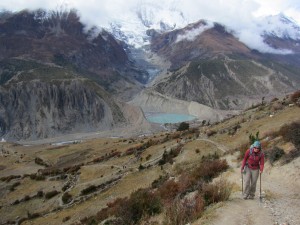
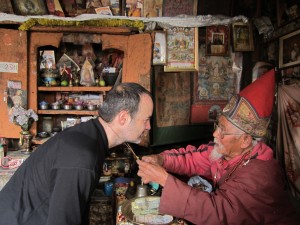
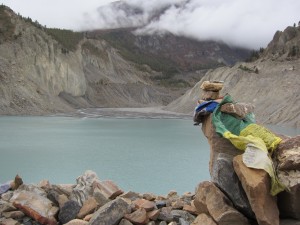
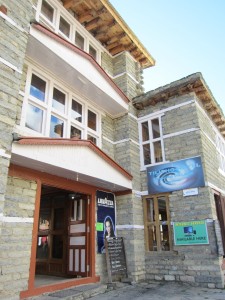
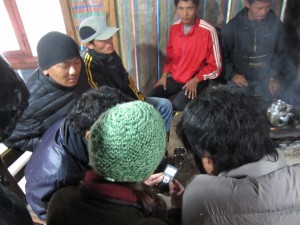
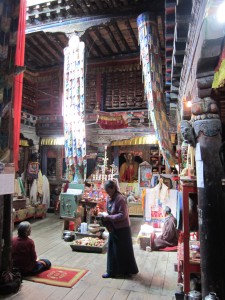
{ 3 comments… read them below or add one }
Allie, I think that there are no fish in the lakes because there is nothing for them to eat. Look at that picture of the lake. No mud, reeds, ducks, bugs, etc. Fish need an ecosystem, not just water; and at that altitude, it’s just rocks and water.
A reasonable theory. What you can’t see in this photo are the water bugs and clay mud. No reeds or ducks though. The lack of fish extended downstream a long way; we were told there were no fish in the river, even at elevations of only 4,000-5,000′ feet where there were all the life signs you mentioned.
Hi both,
looking forward to read the rest. How great that you are still in Nepal! We have been back for over two weeks now, sigh. Enjoy the rest of your stay as much as you can! Oh yes, remember we mentioned the mountain flight? Well, we did that and we can certainly recommend it, should you be interested. Try to get a seat in row 7 (when flying Buddha Air), because then you can go into the cockpit when the plane is turning and you can see Mt Everest clearly. Magnificent view!
Regards from the Dutchies with whom you crossed Thorung La